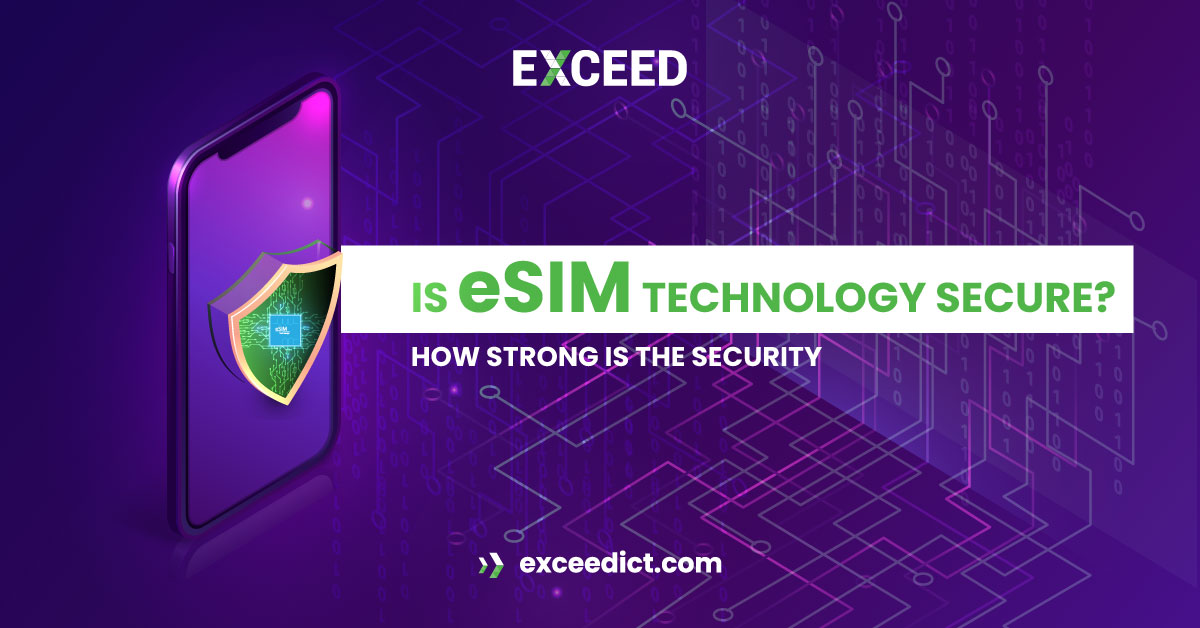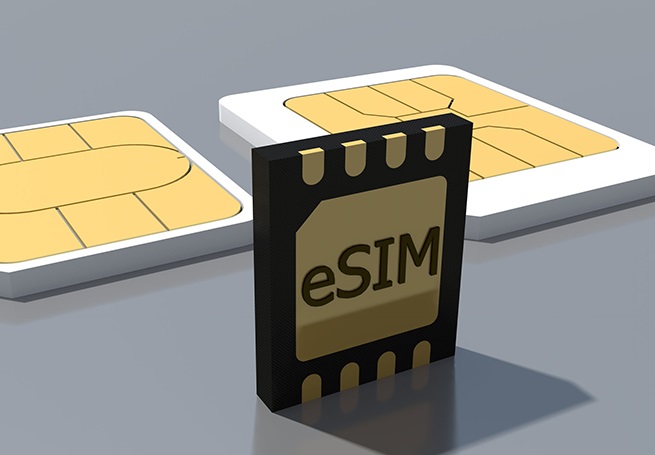
eSIM Technology Security: An in-depth Look at its Strengths and Vulnerabilities
 eSIM technology is a revolutionary advancement in the mobile telecommunications industry that allows users to store their subscriber identity module (SIM) information electronically, instead of using traditional SIM cards. eSIMs offer several benefits, including flexibility, convenience, and better network coverage. But, as with any new technology, concerns about security and safety arise.
eSIM technology is a revolutionary advancement in the mobile telecommunications industry that allows users to store their subscriber identity module (SIM) information electronically, instead of using traditional SIM cards. eSIMs offer several benefits, including flexibility, convenience, and better network coverage. But, as with any new technology, concerns about security and safety arise.
Is eSIM technology secure? How strong is the security?
In this article, we will delve into the security features of eSIM technology, its vulnerabilities, and how it compares to traditional SIM cards.
eSIM Technology
eSIM (embedded SIM) technology is a relatively new innovation in the telecommunications industry that replaces the traditional physical SIM card used in mobile devices with an integrated SIM chip that is embedded directly into the device. This allows for greater flexibility and convenience for consumers, as they no longer need to physically swap SIM cards when changing carriers or upgrading their device.
With eSIM technology, users can remotely download and activate a new carrier plan without the need for a physical SIM card. This is particularly useful for travelers or those who need to switch between carriers frequently, as they can simply download a local carrier plan instead of having to purchase and install a new SIM card.
How does eSIM technology work?
 eSIM (embedded SIM) technology works by replacing the traditional physical SIM card with an integrated SIM chip that is embedded directly into the device. This SIM chip contains all the necessary information required to connect to a mobile network, such as the device’s unique identifier (IMSI) and authentication information (Ki).
eSIM (embedded SIM) technology works by replacing the traditional physical SIM card with an integrated SIM chip that is embedded directly into the device. This SIM chip contains all the necessary information required to connect to a mobile network, such as the device’s unique identifier (IMSI) and authentication information (Ki).
When a user wants to activate a new carrier plan, they can do so remotely by downloading the carrier’s profile onto their device. This profile contains the necessary information to connect to the carrier’s network, including the necessary authentication information. The user can then activate the new plan without the need for a physical SIM card.
One of the key benefits of eSIM technology is that it allows for greater flexibility and convenience, as users can switch carriers or plans without needing to physically swap SIM cards. This is particularly useful for frequent travelers, as they can simply download a local carrier plan instead of having to purchase and install a new SIM card.
In addition, eSIM technology allows for smaller and more compact devices, as there is no longer a need for a SIM card slot. This can be particularly beneficial for wearable devices or other small IoT (Internet of Things) devices, where space is limited.
Overall, eSIM technology offers greater convenience and flexibility for consumers, while also allowing for smaller and more compact devices. While there are still some concerns around security and privacy, eSIM technology is expected to become increasingly prevalent in the coming years as more carriers and device manufacturers adopt the technology.
How secure is eSIM technology?
 eSIM technology, also known as embedded SIM, is designed to be a secure alternative to traditional physical SIM cards. It is a small chip that is embedded directly into a device, such as a smartphone or tablet, and can be programmed with mobile network operator (MNO) credentials, such as phone number and authentication information.
eSIM technology, also known as embedded SIM, is designed to be a secure alternative to traditional physical SIM cards. It is a small chip that is embedded directly into a device, such as a smartphone or tablet, and can be programmed with mobile network operator (MNO) credentials, such as phone number and authentication information.
From a security perspective, eSIM technology offers several benefits and advantages over traditional SIM cards. For example, because eSIMs are built into devices, they cannot be easily removed or tampered with. This makes them less susceptible to physical attacks, such as SIM swapping or theft.
In addition, eSIMs use encryption and secure protocols to protect the data stored on them. This means that they are much more difficult to clone or hack compared to traditional SIM cards.
Furthermore, eSIMs also offer more control and flexibility to users. They can easily switch between different MNOs and plans, without needing to physically swap out SIM cards. This can be especially useful for frequent travelers, who can switch to local plans while abroad.
Overall, eSIM technology is considered to be a secure and reliable option for mobile network authentication and connectivity. However, as with any technology, there is always the potential for vulnerabilities and risks. It is important for MNOs and device manufacturers to continue to implement and maintain strong security measures to protect against potential threats.
eSIM technology is very secure, thanks to the advanced security measures employed by mobile device manufacturers and network providers.
Some of the security features of eSIM technology include:
- Encrypted Data: eSIM technology encrypts the SIM card’s data, making it difficult for hackers to intercept and steal.
- Secure Enclave: The SIM profile is stored in a secure enclave within the device, making it harder for hackers to gain access.
- Authentication Protocols: eSIM technology uses advanced authentication protocols, making it difficult for unauthorized parties to access the SIM profile.
- Remote Management: Network providers can remotely manage eSIM profiles, allowing them to monitor and respond to security threats quickly.
What are the vulnerabilities of eSIM technology?
While eSIM technology is generally considered to be secure, there are still potential vulnerabilities that could be exploited by attackers. Some of these vulnerabilities include:
- Malware attacks: Malware could infect a device’s firmware and gain access to the eSIM data stored on the device. This could allow an attacker to steal sensitive information, such as authentication credentials, phone numbers, and other personal data.
- Remote hacking: A remote attacker could exploit vulnerabilities in the eSIM’s firmware or communication protocols to gain unauthorized access to the device or the eSIM data stored on it.
- Social engineering attacks: Attackers could use social engineering tactics to trick users into providing their eSIM credentials or other sensitive information. For example, an attacker could pose as a mobile network operator and ask the user to provide their eSIM information for verification purposes.
- Physical attacks: While eSIMs are designed to be more secure than traditional SIM cards, they are not immune to physical attacks. An attacker could still physically access the device and attempt to extract the eSIM data from it.
To mitigate these vulnerabilities, it is important for mobile network operators and device manufacturers to implement strong security measures, such as encryption, secure protocols, and regular firmware updates. Users should also be vigilant and take steps to protect their devices, such as installing security software and avoiding suspicious emails or messages.
How does eSIM technology compare to traditional SIM cards in terms of security?
eSIM technology offers several security advantages over traditional SIM cards. Here are some ways in which eSIMs are more secure:
- Tamper-resistant: eSIMs are embedded directly into a device, making them tamper-resistant. Unlike traditional SIM cards, which can be easily removed or swapped, eSIMs cannot be physically accessed or manipulated once they are installed in a device.
- Encryption: eSIMs use encryption to protect the data stored on them. This makes it much more difficult for attackers to access and extract sensitive information from the eSIM.
- Secure communication: eSIMs use secure communication protocols, such as HTTPS and SSL/TLS, to protect the data that is transmitted between the device and the mobile network operator. This helps to prevent eavesdropping and other attacks.
- Remote provisioning: eSIMs can be remotely provisioned by mobile network operators, which means that users do not need to physically swap SIM cards when they want to switch to a new network or plan. This can help to reduce the risk of physical attacks, such as SIM swapping.
- More control: eSIMs give users more control over their mobile network authentication and connectivity. They can easily switch between different networks and plans, and can also delete and re-install eSIM profiles as needed.
Overall, eSIM technology offers several security benefits over traditional SIM cards. However, it is still important for mobile network operators and device manufacturers to implement and maintain strong security measures to protect against potential vulnerabilities and risks.
Frequently Asked Questions:
Q: Is eSIM technology safer than traditional SIM cards?
A: Yes, eSIM technology is generally considered to be safer than traditional SIM cards. This is because eSIMs are built directly into a device, which makes them more tamper-resistant than traditional SIM cards. Additionally, eSIMs use encryption and secure communication protocols to protect the data stored on them and the data transmitted between the device and the mobile network operator.
Q: Can eSIM profiles be remotely managed by network providers?
Yes, eSIM profiles can be remotely managed by network providers. This is one of the advantages of eSIM technology. Network providers can remotely update the eSIM profile on your device, which means you don’t need to physically replace a SIM card when you switch carriers or change your plan. This can be convenient for users and can also reduce waste associated with traditional SIM cards. However, to remotely manage an eSIM profile, the user must have authorized the network provider to do so and have an active internet connection on their device.
Q: Can eSIM technology be used for illegal activities?
Yes, eSIM technology can be used for illegal activities, just like any other technology. However, eSIMs are subject to the same laws and regulations as traditional SIM cards and must be registered to an individual or entity. This means that eSIMs can be traced back to their owner, making it difficult to use them for illegal activities without being caught.
In some cases, criminals may try to use eSIMs to commit fraud or identity theft, but this is not unique to eSIMs and can also be done with traditional SIM cards. It is important for users to protect their eSIM profiles with strong passwords and to report any suspicious activity to their carrier or law enforcement authorities.
Overall, while eSIMs may be used for illegal activities, they are subject to the same regulations and security measures as traditional SIM cards, and can be traced back to their owner if used for illegal purposes.
Conclusion:
eSIM technology is a secure and convenient way to store SIM card information electronically. Its advanced security features, including encryption, secure enclave, and authentication protocols, make it more secure than traditional SIM cards.
However, it is not entirely foolproof, and users should be aware of its vulnerabilities and take precautions to protect their eSIM profiles. Overall, eSIM technology offers a more secure and flexible alternative to traditional SIM cards, and its adoption is expected to continue to grow in the coming years.
visit EXCEED ICT to learn more about eSIM and see how we can help you grow your business. From onboarding and training users to implementing the right security measures, EXCEED ICT can help you get the most out of your mobile devices. Visit our website today to learn more!
Stay connected with EXCEED ICT by joining our social networks (at footer). Get the latest updates, news, and tips for enterprise device deployment. Follow us on Twitter, Facebook, and LinkedIn for the best enterprise device deployment solutions.
Help us to improve our enterprise device deployment solutions by rating us on Google Maps. Your feedback and comments are valuable to us and will be used to make our services even better.
You may also like to read more about
- Which Devices Are Compatible With eSIM Technology?
- 5 eSIM Technology Advantages : Revolutionising the Way We Connect.
- Everything You Need to Know About eSIM Technology in Australia.
- Choose the Best eSIM Data Plan for Your Needs in Australia.


